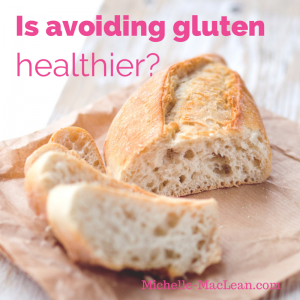The real truth behind gluten
 The CBC’s marketplace aired an episode a couple weeks ago about going gluten free. They focused on the question, “to gluten or not to gluten?” and claimed they were looking to find the “truth behind the trend.”
The CBC’s marketplace aired an episode a couple weeks ago about going gluten free. They focused on the question, “to gluten or not to gluten?” and claimed they were looking to find the “truth behind the trend.”
The investigation was conducted by Marketplace co-host, Tom Harrington, who teamed up with Canadian comedian Darcy Michael who has celiac disease. The pair made their way around a grocery store loading up their cart with various gluten-free products, asking random shoppers their opinion on gluten, and comparing gluten-free and non gluten-free products on nutritional value and price.
Tom also interviewed Timothy Caufield a professor from the Health Law Institute at the University of Alberta, who has studied the food industry’s impact on consumers.
The episode suggested that only those with celiac disease should eat gluten-free products and that food manufacturers are creating these products because of the trend and are maximizing profits off the backs of uninformed consumers. The episode concluded there are many downsides to going gluten-free including it’s more expensive, less nutritious and harder to maintain.
On a few points, I actually agree with the show’s findings. Yes, the gluten-free bandwagon is definitely one that marketers and food processors have jumped on. Yes, gluten free products are more expensive and less nutritious. But I feel the Marketplace feature missed the point and did not get to “the truth behind the trend.”
I believe the wrong question was asked. Instead of “Is eating gluten-free products healthier?” The question should have been, “Is avoiding gluten healthier?”
The program focussed solely on gluten-free products as if those make up the entire diet of someone with celiac or a gluten sensitivity. I was amazed to see Tom’s grocery shopping cart filled with only processed, packaged, manufactured foods. There was not one fruit, vegetable or whole food to be found.
To get to the real truth behind going gluten free, I would have thought the Marketplace investigation would have interviewed a health professional with experience in celiac disease to dig further into the science and physiology of how we digest gluten.
Let’s consider what gluten is and what the science is showing.
Gluten is a a protein found in grains such as wheat, rye and barley. In people with celiac disease, gluten sets off an immune reaction that damages the small intestine and prevents the absorption of nutrients.
Health Canada states that Celiac disease is recognized as one of the most common chronic diseases in the world. It’s estimated it affects as many as one in every 100 – 200 people in North America. As many as 300,000 Canadians could have this disease; with many undiagnosed.
New testing in the last three years is showing that upwards of 30-40 per cent of the population may have some sort of gluten sensitivity.
In his article, Gluten: What you don’t know might kill you, Dr, Mark Hyman refers to a study in the Journal of the American Medical Association, that found people with diagnosed and undiagnosed celiac disease or gluten sensitivity had a higher risk of death, mostly from heart disease and cancer. There was a 39 per cent increased risk of death in those with celiac disease, 72 per cent increased risk in those with gut inflammation related to gluten, and 35 per cent increased risk in those with gluten sensitivity but no celiac disease.
This ground-breaking research proves you don’t have to have full-blown celiac disease to have serious health problems and complications from eating gluten.
So why is gluten sensitivity so common these days?
The gluten content of wheat has gone up by 50 per cent in the last 50 years. Gluten is like glue. It makes baked goods and carb-type products stretchy, sticky, gooey and lighter. So food manufacturers are adding more into their products to make them more appealing.
But the protein structure of today’s gluten is much different than it used to be because it is so highly processed and the digestive system can’t break it down. It’s becoming more of a problem because we are eating so many more of these processed goods.
From the research I have read, it’s clear gluten-free and gluten sensitivity are not trends or fads.
A gluten-free lifestyle should not be made up of processed, packaged, manufactured products labelled gluten-free. What a gluten free diet should look like is one filled with real, whole foods like what our ancestors ate. Fruits, vegetables, nuts, seeds, quality animal and plant-based proteins, eggs and some healthy fats. These products are naturally gluten free and we don’t need marketers and food scientists telling us so.
I agree with Marketplace that gluten-free products aren’t good for you, but a whole foods, naturally gluten-free lifestyle is.
*This post was originally published in the Herald Community on November 4, 2014

Well said,… Great article!
Explained very well Michelle. I totally agree with you.
Gluten gives me terrible insomnia. Interesting article! Especially the part about 35% increase in cancer and heart disease with sensitivity which is not celiac. That would be me. So, glad to hear I have also decreased my serious disease risk as well, by avoiding it.